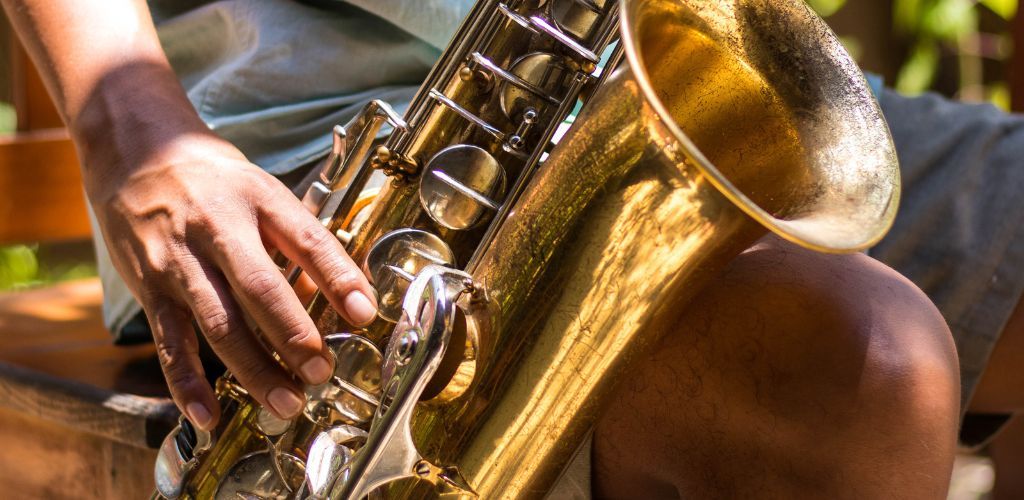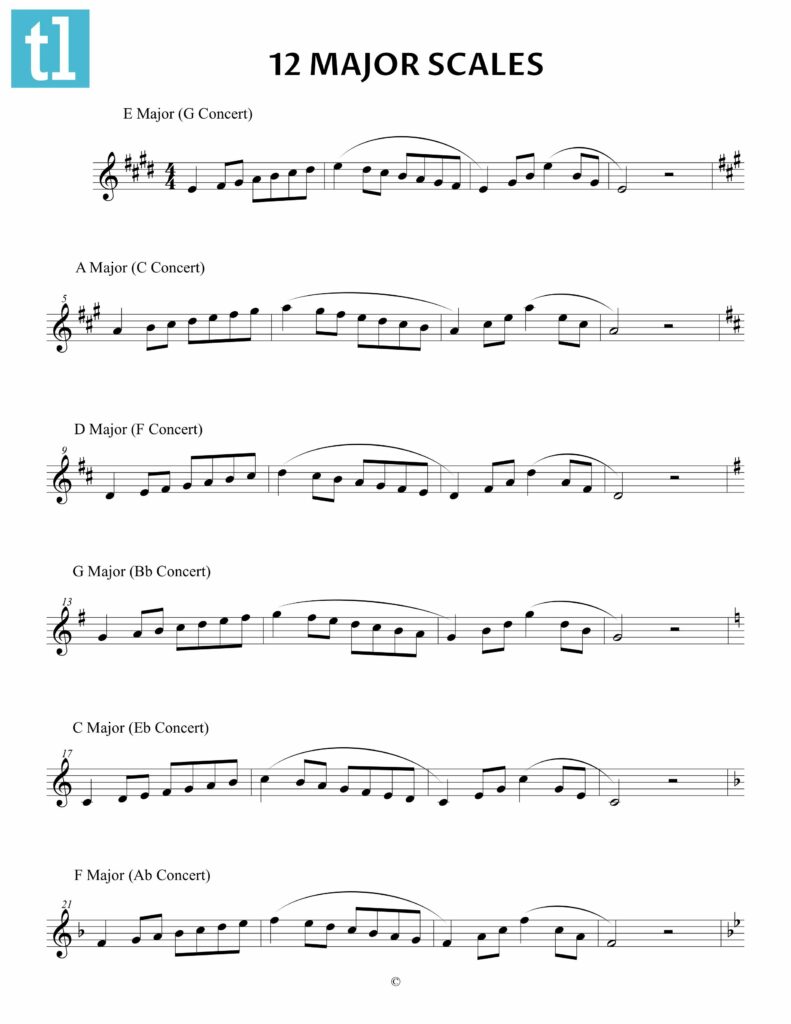Best
Saxophone
for Kids
-
Overall: The new mouthpiece accepts standard saxophone or clarinet reeds
-
Best Feature: Waterproof for effortless upkeep
-
TedScore™: 6.5/10
Best
Overall Sax for Beginners
-
Overall: Beautiful gold lacquer finish with a rich tone
-
Best Feature: Improved B-C# mechanism for easier response
-
TedScore™: 9/10
Best
High-End Sax for Beginners
-
Overall: Produces pure sound with luxurious metals
-
Best Feature: Faster response due to underslung octave key
-
TedScore™: 7.5/10

Learning to play the alto saxophone brings a world of sounds to discover, and having an alto sax fingering chart helps tremendously.
This chart shows you exactly where to place your middle finger or fingers on the keys to produce each note, from low Bb to high F#.
It’s an essential resource for beginners and advanced players and can help you develop your technique and improve your playing.
To get the most out of your alto sax fingering chart, it’s important to understand the fundamentals of saxophone fingering.
So, let’s take your playing to the next level!
Fundamentals of
Alto Sax Fingering
Fingering Basics

When playing the alto saxophone, mastering the great fingering chart is essential. Proper fingering technique allows you to play notes accurately and with ease.
Before diving into the fingering chart, it’s important to understand the basics of saxophone fingering.
Firstly, it’s important always to keep your fingers close to the keys. This will allow you to move quickly between notes.
Ensure you’re pressing the keys down with your fingertips, not the pads. This will give you greater control over the instrument.
Another important aspect of fingering is hand positioning.
Your left hand should be positioned on the upper part of the saxophone, with your thumb and index finger resting on the thumb rest.
Your right hand should be positioned on the lower part of the saxophone, with your thumb resting on the thumb rest and your fingers resting on the keys.
Fingering Chart Key
The fingering chart visually represents the different notes that can be played on the alto saxophone. The chart shows the saxophone notes and the various fingerings for each note.

Reading the Alto Sax Fingering Chart

If you’re a beginner saxophonist, an Alto Sax Fingering Chart is an essential tool that you must have.
It will help you learn the saxophone; even as an advanced player, you’ll need it to perfect your playing technique.
However, reading the chart can be confusing, especially if you’re new to the instrument. This section will guide you through reading the Alto Sax Fingering Chart.
Firstly, it’s essential to understand that the fingering chart visually represents the saxophone’s keys. Each note on the chart corresponds to a specific combination of keys you must press to produce the sound.
The chart displays the fingerings for each note in a logical sequence, making it easier for you to follow.

The chart is divided into two sections: the upper and lower registers.
The upper register includes higher-pitched notes, while the lower register includes lower-pitched notes.
The notes are arranged from left to right, with the lowest note on the left and the highest note on the right.
To read the chart, you need to identify the note you want to play and locate it on the chart. Once you’ve found it, look at the corresponding fingering.
The fingering will show you which keys to press and which ones to release to produce the note.
The chart also shows you which octave key to use to produce each note.
It’s important to note that some notes have multiple fingerings, depending on the context of the music.
For example, a note may have a different fingering if it’s played in a fast passage than if it’s played as a sustained note.
Therefore, practising different fingerings for each note to develop your playing technique is essential.
Common Finger Positions

Below are some of the most common finger positions for the saxophone.
Major Scale Fingerings
The major scale is one of the most important scales for any saxophonist to learn. Here are the fingerings for the major scale:

Minor Scale Fingerings
The minor scale is another important scale for saxophonists. Here are the fingerings for the natural minor scale:

It’s important to note that there are different variations of the minor scale, such as the harmonic and melodic minor. These variations have slightly different fingerings, so it’s also important to learn them.
Advanced Finger Positions

When you’ve mastered the basic fingerings on your alto saxophone, it’s time to start exploring the more advanced alternate fingering charts.
These fingerings will allow you to play more complex pieces and expand your range of notes.
This section will cover two advanced fingering types: chromatic scale and altissimo.
Chromatic Scale Fingerings
The chromatic scale is a musical scale that includes all twelve notes of the Western musical scale. You’ll need to use some alternative fingerings to play the chromatic scale on your alto saxophone.
Here are the fingerings for the chromatic scale:

Note that these fingerings differ from the standard ones you use for the major and minor scales.
Altissimo Fingerings
The altissimo register is the highest range of notes on the saxophone. You’ll need to use some alternative saxophone fingerings to play these notes.
Here are the fingerings for the altissimo range:

Note that these fingerings are more complex than the standard, requiring a lot of practice to master.
Maintenance and Care for Effective Fingering
To ensure that your alto saxophone fingering chart remains effective, it’s important to take good care of your instrument.
Here are some tips to help you maintain your saxophone and keep your fingering accurate:
Dirt, dust, and moisture can build up inside your saxophone, affecting sound quality and fingering. To prevent this, you should clean your saxophone regularly.
Use a soft cloth or a special saxophone cleaning kit to wipe down your instrument’s exterior gently. For the interior, use a swab or a cleaning snake to remove moisture and debris from the neck and body.
The keys of your saxophone need to move smoothly and freely for accurate fingering. To keep them in good condition, you should oil them regularly.
Use a small amount of key oil on a cloth or a needle oiler to lubricate the keys. Be careful not to use too much oil, as this can cause the keys to become sticky.
The pads on your saxophone can wear out over time, affecting the sound quality and fingering. You should check the pads regularly and replace them as needed to prevent this.
Look for signs of wear or damage, such as cracks, tears, or leaks. If you notice any problems, take your saxophone to a professional repair technician.
When you’re not playing your saxophone, storing it properly to protect it from damage is important. Always keep your saxophone in its case when you’re not using it.
Make sure the case is clean and dry, and store it in a cool, dry place. Avoid exposing your saxophone to extreme temperatures or humidity, which can damage the instrument.

Recommended Alto Saxophone for Beginners
Yamaha YAS280 Student Alto Saxophone

PERFECT FOR: Student saxophone players
FEATURES: Beautiful look and rich tone with a gold lacquer finish
OTHER INFO: Easier response from lower notes with the improved, stronger B-C# mechanism
Yamaha YAS280 Student Alto Saxophone
- Register for a 5-year extended warranty and 3-month Tomplay Premium
- Includes case & high-quality 4C mouthpiece
- Yamaha quality creates the best student saxophone
- You might want to upgrade as you advance your playing skills
When you click ‘Check Price’, you’ll see there are loads of great places to buy this item. Our personal favorite is Sweetwater for the US, and Thomann and Gear4Music for the UK & Europe.
They are the largest music retailers, with excellent customer service, competitive prices, really fast shipping, and the longest guarantees.
The professional musician who wrote this article combined many things,
from the product build, manufacturer’s reputation through to feedback
from other users, to create our famous TedScore™.
Nuvo jSax

PERFECT FOR: Younger saxophone learners
FEATURES: The new mouthpiece can use standard saxophone or clarinet reeds
OTHER INFO: Waterproof for effortless upkeep
Nuvo jSax
- Uses traditional saxophone fingering
- Comes in a variety of bright colours
- Includes all necessary equipment
- The reeds are plastic
When you click ‘Check Price’, you’ll see there are loads of great places to buy this item. Our personal favorite is Sweetwater for the US, and Thomann and Gear4Music for the UK & Europe.
They are the largest music retailers, with excellent customer service, competitive prices, really fast shipping, and the longest guarantees.
The professional musician who wrote this article combined many things,
from the product build, manufacturer’s reputation through to feedback
from other users, to create our famous TedScore™.
Yanagisawa AWO37 Alto Saxophone, Solid Silver

PERFECT FOR: Beginners and advanced students
FEATURES: Produces pure sound with luxurious metals
OTHER INFO: Faster response due to underslung octave key
Yanagisawa AWO37 Alto Saxophone, Solid Silver
- Distortion prevention from double-arm bell keys
- Exceptional Japanese construction
- Comes with a wood shell case and mouthpiece
- Price is high for a student saxophone
When you click ‘Check Price’, you’ll see there are loads of great places to buy this item. Our personal favorite is Sweetwater for the US, and Thomann and Gear4Music for the UK & Europe.
They are the largest music retailers, with excellent customer service, competitive prices, really fast shipping, and the longest guarantees.
The professional musician who wrote this article combined many things,
from the product build, manufacturer’s reputation through to feedback
from other users, to create our famous TedScore™.
Alto Saxophone Fingering Chart:
Important Points
The alto saxophone fingering chart is an essential tool for every saxophonist.
It helps players to learn and memorize the various fingerings required to produce different notes on the instrument.
By familiarizing oneself with the chart, players can improve their playing skills and deliver exceptional performances.
So, make sure to have an alto saxophone fingering chart on hand to enhance your sound when playing!
Wait, there’s more!!!
Get ready to discover the Best Saxophone Mouthpiece that will elevate your playing to the next level. From bright and edgy to warm and mellow, these mouthpieces offer a range of tonal possibilities to suit every saxophonist’s style!
FAQ's
A fingering chart is a visual guide that shows the specific fingerings for each note on a musical instrument. It helps musicians learn and memorize the correct finger placement for each note, which is essential for playing accurately and efficiently.
The basic keys on an alto saxophone are the Bb, C, and F keys. These keys play various notes and are the foundation for many scales and melodies.











Really appreciate the section on advanced finger positions. The altissimo fingerings are particularly challenging and it’s great to see them addressed here. Finding the right fingering can be quite personal and it’s a journey of trial and error. Would love to see more on this, maybe some tips on how to discover the ones that work best for individual players. Great article overall, Elaine Booth.
So you’re saying mastering these fingerings is gonna make me a pro? Ive seen dudes do their own thing and kill it without all this formal stuff.
awesome article, really breaks down the basics in a way I get it. thumbs up!
Elaine , thank you for this comprehensive guide. I find the fingering charts particularly useful for my students. However, I’m curious if you have recommendations on exercises or methods to help students transition between scales more smoothly, especially when moving to more complex pieces?
Following this! Also struggling with transitions. Any specific exercises?
Hey, but I’ve found that scale runs and interval training really help with that transition. It’s all about muscle memory.